High-Class Cruiser
Metal/composite construction, gorgeous lines, top-o’-the-line luxury’splendid!
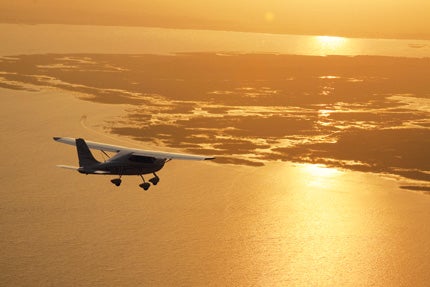 This is the story of three jaw-dropping moments that followed my introduction to the gorgeous, new Tecnam P2008. The first agape moment came after seeing a photo online and trying to post about the plane on my P&P blog: My thesaurus ran out of synonyms for "beautiful" long before I ran out of enthusiasm for word-painting the new metal/carbon-fiber S-LSA. Here, I thought, is the complete aeronautical designer's skill at work: form plus function, with a decidedly scintillating emphasis on form.
This is the story of three jaw-dropping moments that followed my introduction to the gorgeous, new Tecnam P2008. The first agape moment came after seeing a photo online and trying to post about the plane on my P&P blog: My thesaurus ran out of synonyms for "beautiful" long before I ran out of enthusiasm for word-painting the new metal/carbon-fiber S-LSA. Here, I thought, is the complete aeronautical designer's skill at work: form plus function, with a decidedly scintillating emphasis on form.
On my demo flight at Sebring, Fla., with Tommy Grimes, the affable president of Tecnam North America, he likened the new airplane---the first in America---to a supremely appointed Mercedes sedan. Tecnam has gone all out here. The construction and finish are top-drawer. Appointments and the glass-loaded, stylish instrument panel fully complement the sleek, flowing exterior.
Romantic visions sail through my mind. I imagine a corporate CEO and his companion---he in black tuxedo, she in a shimmering silk gown---floating with sublime gravitas to a nearby benefit gala in the P2008. "I say, Carlton, did you load my golf bag? Oh, behind the seats? Good man." All that seems lacking is a name befitting this beauty: "P2008" just doesn't cut the Grey Poupon, my good man.
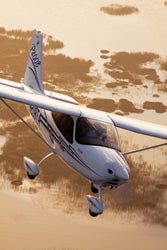 |
Before we fly with the affable Mr. Grimes, a few words about Tecnam. The Italian company has a long and colorful aviation history dating back to 1948. Since 1992, it has focused on LSA, and with 3,000 light aircraft sold, it's the largest light-sport manufacturer in the game.
Tecnam has the LSA model range fully covered, from the P92 Eaglet trainer---one of my favorite fun-flying LSA---to the P2002, P2004, P92 Echo Classic and, now, the P2008. With its recent acquisition of Spain's CAG---the composite company that designed and built another gorgeous S-LSA, the Toxo---Tecnam now is well-versed in metal- and composite-building expertise.
As Tecnam North America's CEO Phil Solomon told me at Sebring, the hybrid design was intended to maximize the benefits of both technologies: "We wanted it to look the best it possibly could by taking advantage of the strength and lightness of carbon fiber while not losing the capability for easy repair that metal structures bring."
Inside and out, the P2008 is luxurious. But how does it fly?
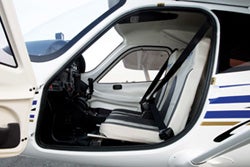 |
First Jaunt
Okay, let's climb aboard. Hmmm!nice big elliptical windows. Tinted, too. A bit of a wicked look. Great views out, down and sideways. Spacious front-hinged doors open wide for easy climb-in. Leather seats are very comfy, unlike some LSA. Wall-to-wall carpeting; map and storage pockets; roomy luggage area behind the seats.
Tommy climbs in. Plenty of room for both of us with a 46.8-inch-wide cabin. The armrests are nice. The stylish gray/charcoal metal panel exudes Euro industrial techno. Tons of avionics and EFIS glass...wow!
"Oh, Carlton: the Times, my pipe and slippers, please...there's a good man."
Tommy guides me through start-up of the Rotax 912 ULS2. The two-blade GT prop spins to life. Seat belts tight? Let's go!
Cleared by the tower, we taxi across the asphalt. Up ahead, I expect a jolt from a sharp asphalt lip...but we roll right over it, smooth as butter.
"Soft gear," I say, enjoying the limo-smooth ride.
"The mains are tubular steel," says Tommy, toggling in 10 degrees of takeoff flaps.
I gun the Rotax, and we roll down runway 14.
"What do I want to lift off at?" I ask---at the very moment the airplane floats off, just above 50 KIAS.
"About right there!" he jokes.
"Gee, that was hard."
The air show pattern requires a sharp right turn immediately after liftoff. I roll the stick over. The P2008 responds smoothly, with firm but not heavy stick force. Piece of cake: I feel like I know this airplane.
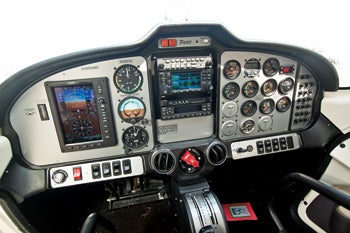 The P2008 avionics panel can be customized to include two glass displays, autopilot, XM weather and backup GPS. The 46.8-inch-wide cabin comfortably seats two and features leather seats, front-hinged doors and large elliptical windows. |
I cross over Lockwood Aviation's hangar, then angle out between the east-west runway and Sebring's Grand Prix race track. The maneuvering is required for the mix of GA and LSA traffic and to avoid the air show folks below.
"What are we looking for in climb speed?" I ask.
"About 80, I like to keep the nose down with all this traffic."
Eighty it is as my host retracts takeoff flaps.
"Notice how it doesn't drop nose much pulling flaps?" Tommy asks.
Indeed, if I had even made a pitch correction, it hadn't registered consciously.
"Yeah! Really smooth. Very nice."
"Well, we think of it as a Mercedes."
"Oh, Carlton...is the caviar in the map box?"
Jaw Drop #2
Climbing to altitude, that initial few seconds of solid/smooth/comfortable sensation grows quickly into another jaw-drop moment: Was I drugged and switched to a Cessna? Flying this airplane is so effortless, so...creamy.
We cruise out over the lake. The sky is murky; rain later? Tommy calls my attention to the windy conditions. I hadn't even noticed---nice. That's the metal wings and stabilator absorbing the bumps.
Early on, I notice a hands-off tendency to creep into a right bank. "Yeah, we had no time to rig it properly," Tommy explains. "It came in the box last week; I flew it first time a few days ago! Flew just like a Tecnam, but a little heavier---a real ’cruiser.' Then I flew it six hours down here, and didn't feel beat up when I arrived. Just locked the stick in my knees and enjoyed the view. It's very quiet, with little vibration, like a larger airplane."
I like the panel: no body contorting needed to reach things (fuel selector, electrical flap switch, light switches, throttle, choke). Placement is logical and, therefore, uncomplicated. The row of big rocker switches (fuel pump, avionic master, panel lights) anchoring the handsome panel is tasty, too. "The metal panel makes it easy," Tommy explains, "to load up anything the customer wants. We can just cut the holes and pop things in." Onboard are a Garmin G3X (GDU375 with XM weather) and a Garmin 430 to lead the way, as well as backup steam gauges. A Garmin SL40 is used as a second radio, and a Garmin 240 for the audio panel. Autopilot is a Trio Pro-pilot.
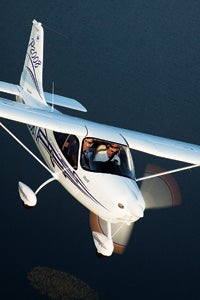 |
Time for airwork.
Turns left and right require little rudder, but the rudder is sensitive and I'm tending to over-yaw a bit. "You don't have to push the pedals," Tommy suggests, "just touch ’em."
Pitch is fairly light, too, but not of the "whoopsie!" potential as with, say, the SportCruiser. I snap the stick back, then take my hand off to investigate dynamic stability. The P2008 climbs, then slows; the nose descends, speed increases; nose comes up, airspeed drops again; the nose settles back into trim attitude: classic phugoid.
"Very stable airplane," I say. Tommy just smiles and nods. With 8,000 GA hours under his belt, this is home turf for him.
I like the spongy stick. I like flying it with thumb and one or two fingers. Departure stalls under power? Nominal is the word: With the slight burble near the break, relaxing the stick brings it back to flying speed. I set up an approach stall in descent, with throttle at idle.
"Okay, easing back on the stick; there's 40 knots, 39, bit of rudder to center up, and there's the burble and slight forward stick and, bingo, we're flying again."
The P2008, with its near-120-knot cruise, is a traveling airplane with gentlemanly manners. "There's no reason this can't be an IFR airplane, too," adds Tommy.
Empty weight is 780 pounds and useful load is 540 pounds.
Time for landing. We slide into the pattern over the raceway.
"Okay, turning base for one four, there's 70 knots..." I say.
"Putting in some flaps," Tommy says. The nose barely rises.
"Thanks...the throttle knob is comfortable, I like it...still hot into final at 70...little high too..."
"More flaps."
"Rounds out nice and smooth...65 now...there goes a turkey vulture...looking good...over the fence, throttle at idle...63, still a bit high..."
"Rest of the flaps coming in..."
The Tecnam feels so sure in my hands. Tower calls an eight-knot wind 10 degrees off our nose, but I can't even feel it. Now ease back for the flare, and it settles firmly on the mains.
"Nice job," Tommy says.
"Thanks! Nice airplane!"
Jaw Drop #3
Tecnam North America CEO Phil Solomon gave me my third agape moment when I asked about the sticker price: "We're pricing it just below $170,000."
"Oh, Carlton! Call my broker and sell the Toyota stock."
"That's a flyaway price, of course," he added.
"It's our preferred package: All the equipment an owner could ever possibly need, including twin glass displays, autopilot with altitude hold, satellite XM weather, backup GPS and more."
VP of Marketing Ben Young updates the numbers as we go to press: "We're offering three prices for the P2008, starting with the Day/Night Tourer package at $155,000. We'll also customize just about any way the customer wants. This airplane appeals to pilots looking for something luxurious and comfortable. Our first customer, who takes delivery mid-June, has a Cessna 182. He bought the P2008 because it's a more cost-effective way to fly the way he likes to fly."
The airplane offers the luxury market a top-of-range ultimate LSA that rounds out Tecnam's already deep and diverse line of LSA---and carries the company closer to Solomon's stated goal of being light-sport's numero-uno manufacturer...by 2014. The P2008 is surely a bold---and surpassingly beautiful---step in that direction.

Subscribe to Our Newsletter
Get the latest Plane & Pilot Magazine stories delivered directly to your inbox





